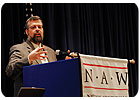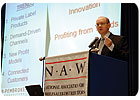
Lightning bolts include the most steeply declining home prices in 40 years, which the economist sees as the beginning of a national correction lasting into 2009. He also thinks China is headed for an economic slowdown, which will impact the U.S. in a negative way.
Most troubling to him is the inverted yield curve, with short-term interest rates higher than long-term rates. According to Beaulieu, “Five out of the last five times that happened, it led to recession.” By his economic reckoning, the time frame for the next one to hit is 2009. “Retail sales is the heartbeat of our economy,” he noted. “It had record high activity in 2006. When you see the rate of growth slow to 2 to 2.5%, be worried. It signals the onset of recession.”
Beaulieu was a featured presenter at this year’s annual Executive Summit of the National Association of Wholesaler-Distributors (NAW), held Jan. 30-Feb. 1 in the nation’s capital. Perhaps the most engaging public speaker in a profession not noted for podium dynamics, Beaulieu balanced his recession forecast with an otherwise upbeat outlook about the long-term economic prospects for the U.S. and the distribution industry.
“We are still the go-to nation on Earth,” he stated, pointing out that the U.S. accounts for 28.4% of the world’s gross domestic product. Beaulieu added, “We have a short-term demographics problem. Europe, China and Canada have a long-term problem. That’s because the U.S. is the only industrialized nation that has a replacement birth rate.”

“Global Opportunities For U.S. Distribution”
Beaulieu also moderated a panel discussion with that title focusing on global outsourcing. Panelists were three large distributors telling of their experiences with private label goods imported from China. Andrew Berlin of Berlin Packaging, Jay Brown of Do It Best Corp. and Steve Johnson of Turner Rocky Distributing all told of highly profitable private label ventures, but with lessons learned by trial and error. Their advice to other distributors included:
Beaulieu’s contribution to this discussion in large measure was to discourage investment in China. “Using China as a low-cost producer will only be good for a few more years,” he predicted. He said as time passes, India, Vietnam and Mexico will grow more inviting.
His dim view of China stems from a host of social and economic instabilities plaguing that country, leading to civil unrest and environmental degradation. “These problems will take time and resources to fix, and with great potential for internal disruption,” said Beaulieu.

Facing The Forces Of Change
Another featured speaker was renowned distribution consultant and author Adam Fein, who gave a preview of his updated Facing the Forces of Change 2007 trends overview, published by NAW. He focused on four key trends now impacting the distribution industry at-large.1: Private label products. An NAW survey found that 43% of distributors do private labeling, with two-thirds of them manufactured overseas, mainly in China. Benefits are plentiful, topped by the ability to command hefty gross profit margins. The downside includes many supply chain risks. To illustrate the growth of this business, Fein pointed out that there are around 300,000 logistics companies now operating in China, compared with 10,000 in the U.S.
2: Demand-driven channels. This trend refers to transactional data mining by distributors and sharing the data with manufacturers. While acknowledging a traditional reluctance on the part of distributors to communicate point of sale and product movement data with vendors, technology now provides “an opportunity to package such information for vendors and put a value on it,” said Fein.
3: New profit models. “‘Buy low, sell high’ is no longer in effect,” said Fein. He noted that distributors in many industries are adopting new purchase and pricing mechanisms such as “pay for performance” - i.e., charging vendors for increasing market share or other performance parameters. According to Fein, fee-for-service pricing is also gaining steam in some distribution industries. These pricing models feature a basic price with additional margin tacked on for services such as pre-assembly, kitting, engineering services, etc.
4: Connected customers. Fein spent more time talking about this trend than any other. He pointed out that about half the population is now connected to the Internet. “The number one thing people do on the Internet is communicate,” said Fein. “People join communities, share experiences, get news, gather information, comparison shop and buy stuff. Your online marketing budget should be growing.” He asked rhetorically, “How are you dealing with the fact that your customers are getting smarter?”
Graybar's BIG Gamble
Another noteworthy presentation at NAW’s Summit was a detailed explanation by Graybar Electric Senior Vice President and CFO Beatty D’Allessandro about his company’s momentous change in 2003 to a system-wide Enterprise Resource Planning (ERP) system that he called a “bet the company” transition.Graybar is a $5 billion electrical distributor that has been around since 1929, when it was spun off from Western Electric and sold to employees. Several years ago its computer system was running out of capacity at the same time business regulations and customer demands were getting more complex. The company decided to turn to ERP, which integrates all computer operations. D’Allessandro noted that it required Graybar to change 75% of its business practices to accommodate the way the software preferred to do business.
The process was disruptive, but managed successfully, thanks to intensive involvement by the company’s executive leadership. In the end, Graybar’s business enjoyed numerous process and performance improvements, topped by a whopping 70% increase in operating margin and 208% net profit gain. Graybar’s CFO told of unanticipated benefits stemming from richer data. “It’s the difference between looking at the business through a microscope and a magnifying glass,” said D’Allessandro.
Graybar was assisted in the ERP transition by Deloitte Consulting. Deloitte’s Neil Gholson also spoke at this session and noted it was the first time they had adapted ERP to wholesale distribution.
Accidental Employment
One other presentation worth noting was NAW Chairman (Graybar Electric’s CEO) Robert Reynolds Jr.’s traditional address, in which he spoke of “Recruiting, Engaging and Retaining Talent.”“Lots of people seem to stumble into our industry as opposed to seeking out the great career opportunities we provide,” he stated. Reynolds called “attracting people - the best people - our industry’s No. 1 challenge.”
He cited a study showing that best practices companies in other industries devoted on average 2.5% of total payroll expense to training, as opposed to just 0.1% for wholesaler-distributors. “This is a problem that is largely within our control to solve.
“And we really have no choice but to solve it. As the demographics continue to shift, we must do a better job of competing for talent against other companies, other industries and other countries to meet the ever-increasing demands of our customers,” said Reynolds.
